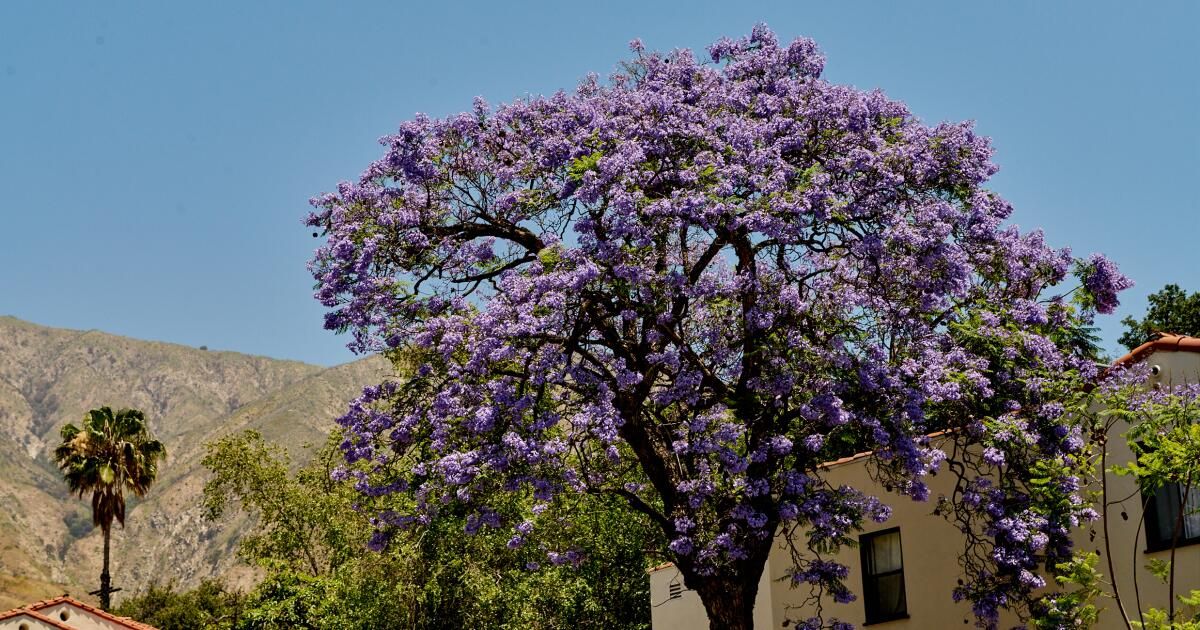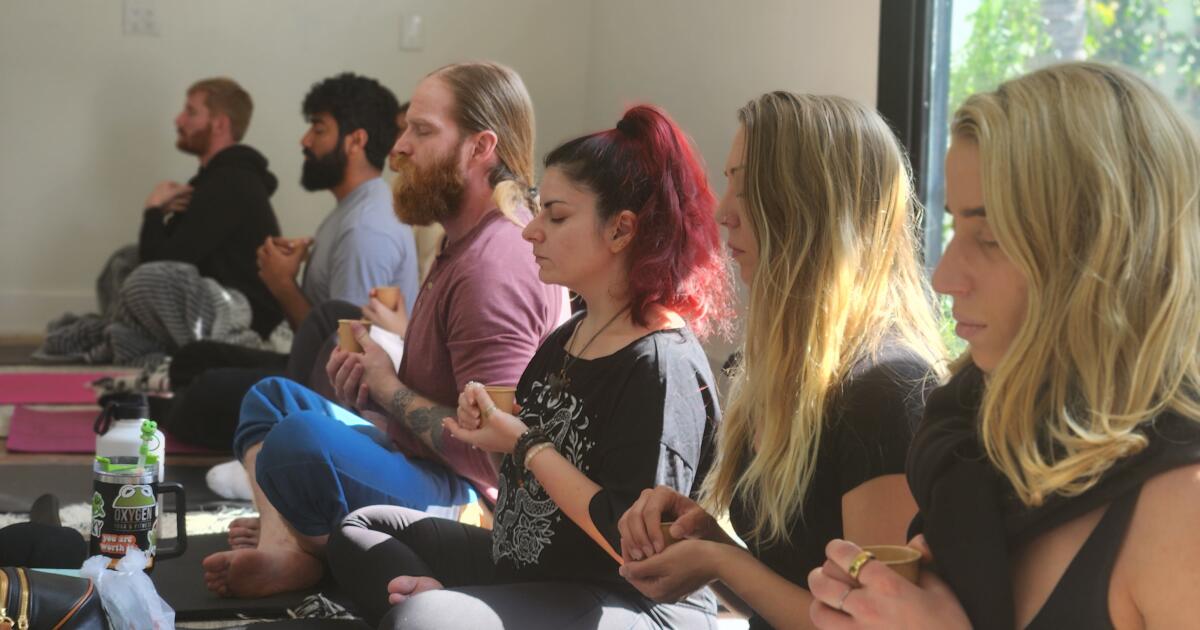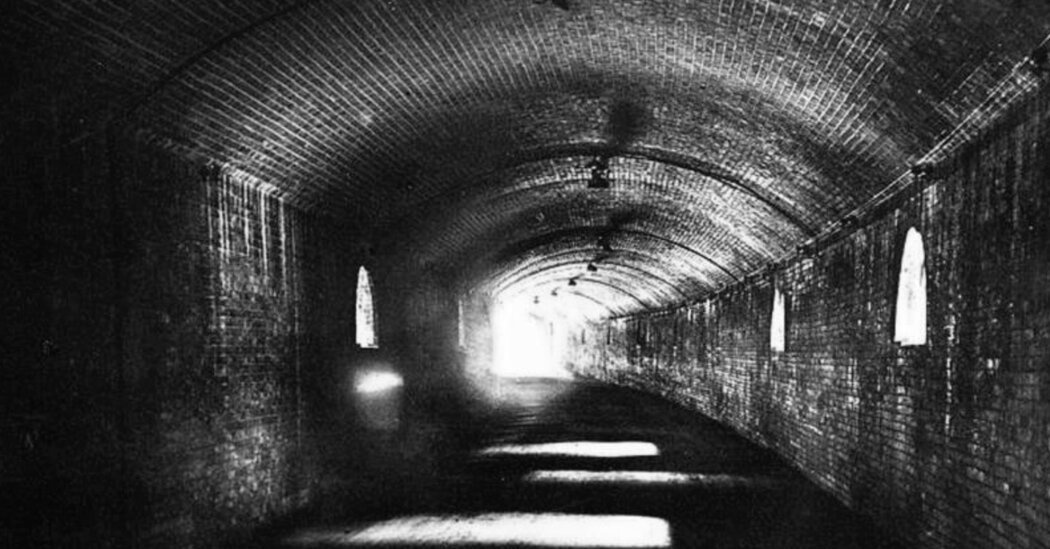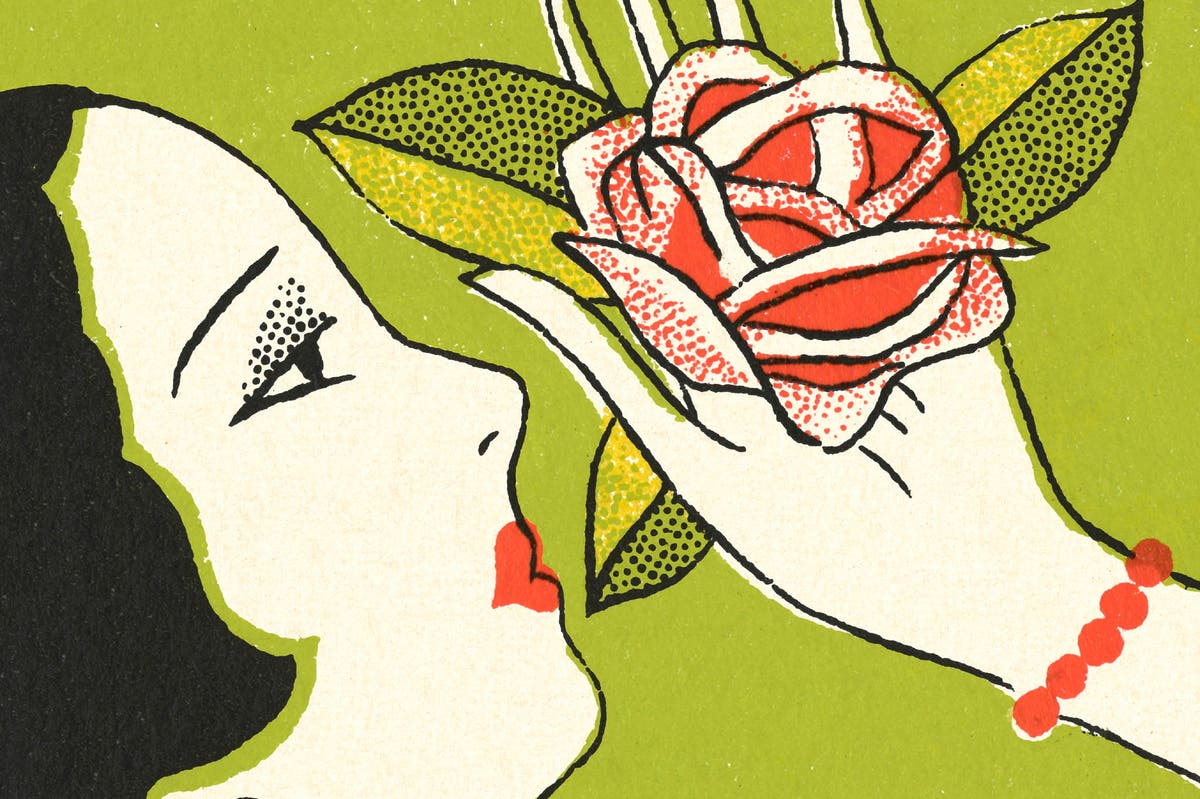It was the tradition of Alexis Murphy photographing the jacaranda who monitored his childhood house in Pasadena. One year, he organized his violet excrements in the form of a heart. Another year, he made them a smiling cartoon face.
But this spring, after Eaton Fire de January burned his childhood house and jacaranda along with her, the scene was too gloomy to capture. Where the extremities of the aged tree once exploited in Violeta, the sung branches crossed in colorless sterility as an unfinished paint.
Alexis Murphy did not expect his Jacaranda tree to flourish this year after partially burned in the January Fire Eaton.
(Yasara Gunawardena / for the Times)
Murphy didn't want to publish something too depressing. So he hooked a flower from a neighbor and filmed a foreground of the flower, leaving his burned tree.
It was then that he saw him.
Just discernible in the gloom of May, a purple flash shone from the Jacaranda canopy; Near, seed pods dotted with green. The tree was in flower.
“Oh, my God, maybe he returns,” he said, halfway by the revival of the tree.
Jacarandas, among him More divisive Of the species of imported plants of Los Angeles, they have long meant Angelenos the arrival of warmer and more vibrant days. Its symbolic weight has been greater for those who lost their homes due to the January forest fires that devastated the Los Angeles County, as well as the stripes of their natural landscape.
“Any tree that is escaping or recovering is a sign of hope for all, and I think people really rejoice in that,” said David Card, a resident of Pacific Palisades and president of the Board of the Palisades Forest Committee.

“Maybe not everything is fatality and gloom,” Alexis Murphy said when he saw the flowers in the canopy of his burnt jacaranda tree.
(Yasara Gunawardena / for the Times)
“At this time, it is the jacarandas that are the center of the stage,” Card said.
A jacaranda flower after fire
Originally from subtropical South America, Jacarandas generally flourishes around May and June, taking its example of the first constant heat stretch of the season. In the wettest years, trees 25 to 40 feet may not expel flowers until July.

Alexis Murphy touches the burnt jacaranda tree that previously monitored her parents' house since then in Pasadena.
(Yasara Gunawardena / for the Times)
This year, hot spells in May encouraged some early flowers, said Lisa Smith, an arborist consultant and president of the firm who consults the trees, The Tree Resource.
Even so, at the time of January fires, semi -deciduous trees had not yet flourished, which probably minimized the damage they suffered.
The arborist said that what also helped is that jacarandas are highly heat tolerant and generally planted among low pastures instead of high bushes, which limits the potential of ascending burns.
“They are a fairly resistant and tolerant species. They can handle hard conditions,” said Smith.
Because the jacarandas throughout the county suffered important damage to the coal of the cortex and the crown, the purple flowering of Los Angeles lowered some patches this year. The problem could get worse. The healthy flowering in trees like Murphy's could be a “false beginning” that is the plant's disease, said Smith.
It is known that trees experience Delayed deaths years after a forest fire has been extinguished.
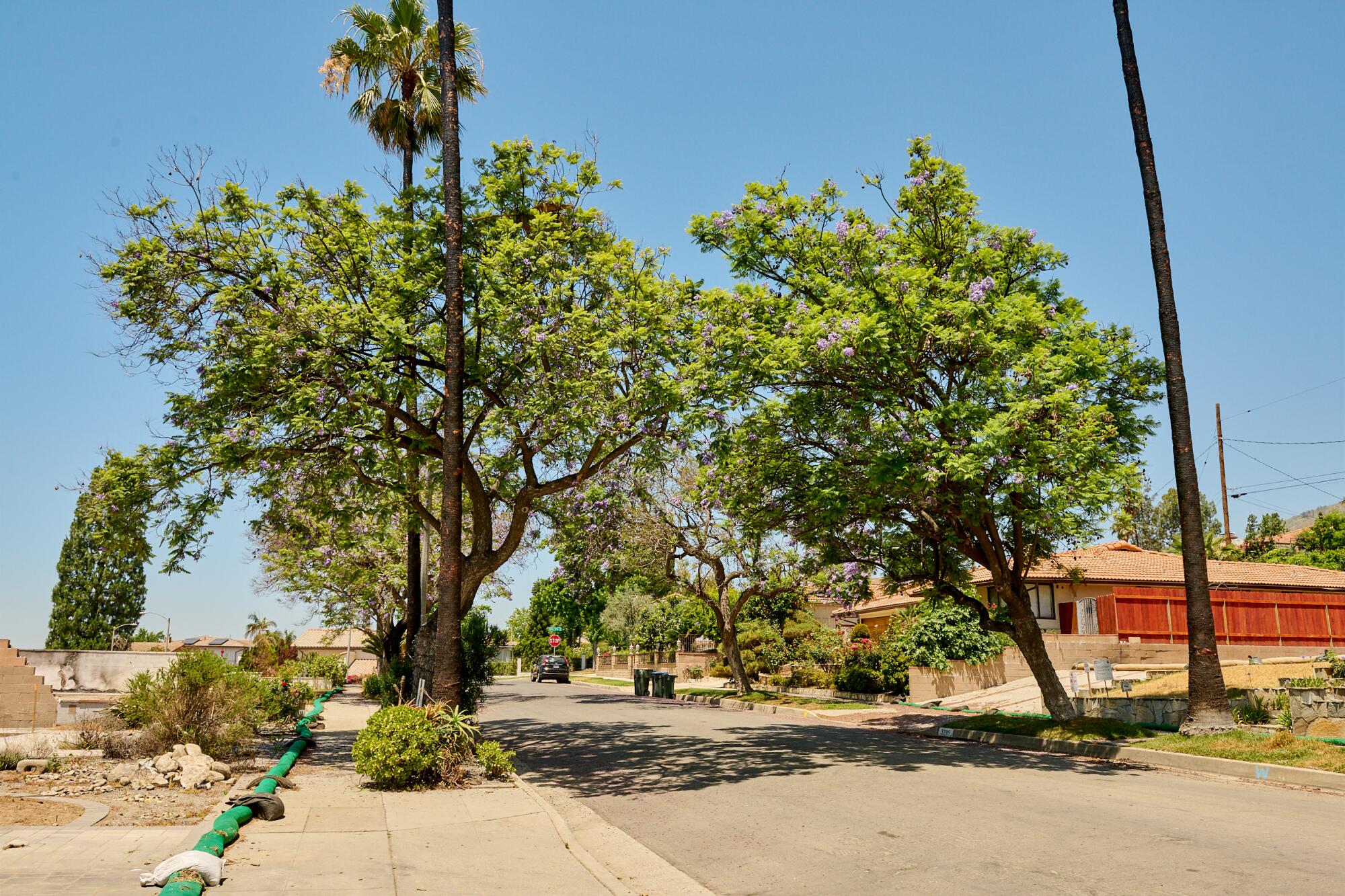
Even in cases of more severe scars, Biology professor Gretchen North said: “It seems that Jacaranda will recover.”
(Yasara Gunawardena / for the Times)
However, Pasadena researchers and Pacific Palisades shared positive perspectives for the future recovery of trees.
Gretchen North, a biology professor at Western College, said that the plant recovery efforts on the guns on Altadena have revealed that Jacarando has “markedly well.”
“They are blooming, although they are burned at the base,” North said. The professor added that most of the damage is limited to the burned cortex. In cases of more severe scars, North said: “It seems that Jacaranda will recover.”
In Las Palisades, this year's trees began to bloom long before expected, Card said.
Speaking for trees
However, experts warned that Los Angeles trees, including Jacarandas, still face threats from recovery efforts after fire.
On the one hand, construction activities such as excavation and compaction of the soil due to heavy machinery can damage the critical root zone of a tree, avoiding the absorption of water and crucial nutrients for the survival of the plant.

For many Jacaranda lovers, preservation work was an instinctive reaction, such as protecting a child from a blow.
(Yasara Gunawardena / for the Times)
On a broader scale, the activists said that the FEMA Joint Cleaning Efforts and the US Army Engineers.
“They were bringing people of states so far that they never listened to Jacarandas,” said Carl Mellinger, an consultant arborist and member of the Palisades Forest Committee.
“In my opinion, if you can't say what the tree is, it has no business that identifies its fiber construction period,” said Mellinger.
A spokesman for the US Army Engineers. UU. He said that “every decision on the elimination of trees is taken thoughtfully and with the expert orientation of professional arborists.”
“While we strive to preserve as many trees as possible, the progress of public security and recovery must be the first,” said the spokesman. “We continue to work in close collaboration with the owners, the county groups and the community to make informed and responsible decisions on the elimination and preservation of the trees.”
A FEMA representative declined to comment.
Mellinger was able to work with a colonel to change the army body protocol and minimize mistakes, he said: “But there were still trees that were going to cut, even though they were viable.”
The residents whose injured trees were retired were surprised to be more distressed by losing the trees, which would take decades to grow again, to lose their homes.
Luann Haslam, the neighbor next to Murphy in Pasadena, said that losing his jacaranda felt like a second wave of pain after his house burned. For more than 25 years, he marveled from the tree, one of his favorites adorning the street. When every spring flourished, covering her grass with purple flowers, she begged her husband: “Don't clean them!”
Haslam said he didn't see the cleaning team remove the tree this year. She couldn't stand it.

For more than 25 years, the resident of Pasadena, Luann Haslam, marveled from the jacaranda tree in his street. (Luann Haslam)

For Halam, losing his jacaranda felt like a second wave of pain after his house burned. (Luann Haslam)
“That is a reason why I really pushed the colonel that you can't cut these trees that will do it,” said Mellinger.
“People have already gone through a disaster,” he said. They do not need to endure another.
The Palisades Forest Committee in March published a exemption For owners who allowed them to retain the so -called “dangerous” trees in their property. Card said the system has worked largely, except for an occasional complication of a contractor too aggressive.
However, the arborists and activists agreed that the regulations of zone 0 can mean problems for those who work to preserve the natural landscape of the Palisades. Defense space directives, aimed at minimizing the risk of burning for homes and other structures, are ready to drastically reduce the amount of trees allowed in the residential neighborhoods of Los Angeles, North said.
The trick, said North, will balance the security guarantees that cities require with the green recovery that their residents need to advance.
The flowers of your work
Many factors that affect the potential for survival of burned trees, including jacarandas, are out of individual control: the level and frequency of rain, the rhythm of cortex generation, the passage of time.
Even so, the arborists said residents can take several steps to improve the chances of recovery of their trees.
The most critical factor, Smith said, is water. Without it, dozens of Jacarandas will not even arrive during the summer.

Arborists advise health jacarandas to health: “Do not seek perfection.”
(Yasara Gunawardena / for the Times)
“Don't look for perfection. Just get water in the tree,” Smith said. He added that those who live far now can ask a neighbor or friend to place a Tree Irrigation Bag Around the trunk of the injured tree. In this way, the water is slowly released, dripping to the roots.
Smith added that if the tree can get fresh leaves, residents can prune their dead branches and leave the living to foster “new significant growth in canopy.”
A good visual signal for a recoverable tree is the growth of the new crust under its burned outer layer, said Mellinger.
“You have to scrape the bark or cut under the bark to try to find the living tissue that is under the Cambium and the inner bark,” he said.
Eliminate dead crust before watering a burned tree can also protect it from pests and pathogens, said Jim Henrich, a curator of live collections in the Los Angeles County Arboret and the Botanical Garden.
Priority No. 1, Henrich said, ensures that the water really saturates the ground. After that, all you really can do is wait.
For many Jacaranda lovers, preservation work was an instinctive reaction, such as protecting a child from a blow. Valeria Serna of non -profit climate Palisades Resilient recently bought a 500 gallon water tank in her own penny and took him to several neighborhoods that lacked access to water.
Vicki Warren, on the other hand, was not very concerned about the fate of the Jacaranda outside the house of his late father, who burned in the fire of Palisades. It was the Magnolia in the backyard he loved.

Vicki Warren's deceased father's house burned in the fire of Palisades. Only the jacaranda outside the house survived.
(Vicki Warren)
But when the body of the Army withdrew his beloved tree this year, everything that was left was the Jacaranda, who for years had left his sticky car with SAP and struggled to the street.
One day in May, Warren parked in the place on Radcliffe Avenue, which had trained to avoid, just below the purple giant. Then she made a promise.
“You and I are the only ones that remain here,” he told the tree.
“I'm going to take care of you.”

